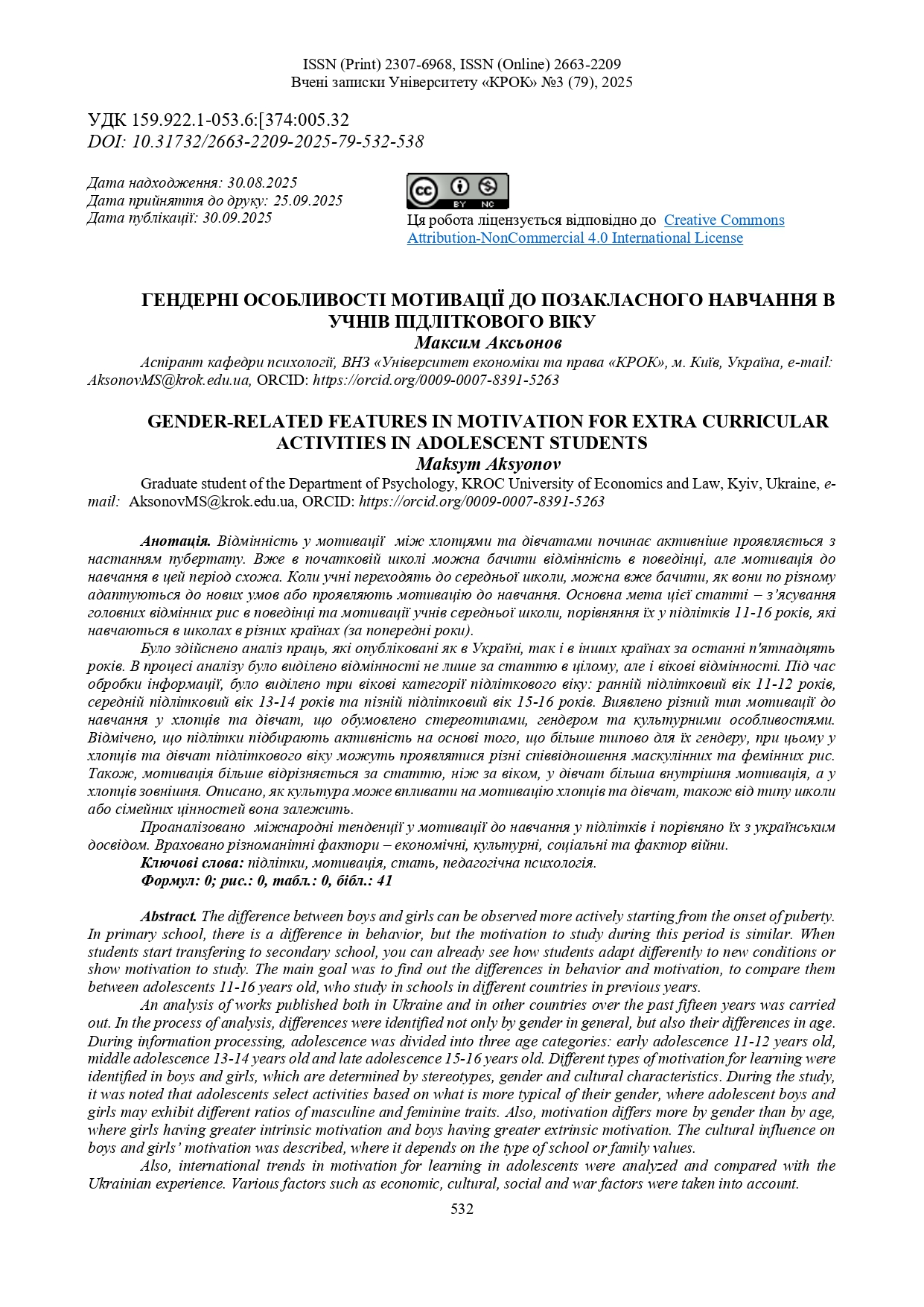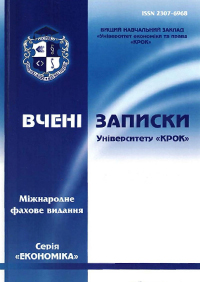GENDER-RELATED FEATURES IN MOTIVATION FOR EXTRA CURRICULAR ACTIVITIES IN ADOLESCENT STUDENTS
DOI:
https://doi.org/10.31732/2663-2209-2025-79-532-538Keywords:
adolescence, motivation, gender, educational psychologyAbstract
The difference between boys and girls can be observed more actively starting from the onset of puberty. In primary school, there is a difference in behavior, but the motivation to study during this period is similar. When students start transfering to secondary school, you can already see how students adapt differently to new conditions or show motivation to study. The main goal was to find out the differences in behavior and motivation, to compare them between adolescents 11-16 years old, who study in schools in different countries in previous years.
An analysis of works published both in Ukraine and in other countries over the past fifteen years was carried out. In the process of analysis, differences were identified not only by gender in general, but also their differences in age. During information processing, adolescence was divided into three age categories: early adolescence 11-12 years old, middle adolescence 13-14 years old and late adolescence 15-16 years old. Different types of motivation for learning were identified in boys and girls, which are determined by stereotypes, gender and cultural characteristics. During the study, it was noted that adolescents select activities based on what is more typical of their gender, where adolescent boys and girls may exhibit different ratios of masculine and feminine traits. Also, motivation differs more by gender than by age, where girls having greater intrinsic motivation and boys having greater extrinsic motivation. The cultural influence on boys and girls’ motivation was described, where it depends on the type of school or family values.
Also, international trends in motivation for learning in adolescents were analyzed and compared with the Ukrainian experience. Various factors such as economic, cultural, social and war factors were taken into account.
Downloads
References
Антонова, З., & Гладка, О. (2024). Мотивація як засіб впливу на прокрастинацію в учнів старших класів.
Білюченко, Ю. М. (2022). Психологічні передумови розвитку ірраціональних переконань у підлітків. Актуальність та особливості наукових досліджень в умовах воєнного стану: зб. тез міжнар. наук.-практ. Інтернет-конф. з нагоди відзначення Дня науки-2022 в Україні. (с. 201-203). Київ.
Грушецька, В. Л. (2023). Особливості мотивації навчання у підлітків в умовах воєнного стану. (Дисертація, Київський університет імені Бориса Грінченка). Електронне архівне сховище КУБГ.
Дзюба, Т. М. (2024). Самодеструктивна поведінка підлітків як форма негативного переживання травматичного досвіду. Редакційна колегія, 299.
Єрофєєва, Н. В. (2022). Гендерні особливості поведінки підлітків у конфліктних ситуаціях.
Завгородня, О. В., Мінаєнко, Т. А., & Депутат, В. В. (2021). Гендерні аспекти адаптації підлітка до середньої ланки школи. Вчені записки, 82.
Іщенко, Т. В. (2024). Вплив тривожності підлітків на навчальну мотивацію в умовах воєнного стану.
Курдибаха, О. М. (2017). Психологічні особливості гендерної соціалізації підлітків в умовах позашкільних навчальних закладів [Дисертація].
Марченко, О. Ю. (2019). Теоретико-методологічні основи гендерного підходу до формування аксіологічної значущості фізичної культури у школярів.
Матохнюк, Л., & Швець, В. (2025). Розуміння власної гендерної ідентичності сучасними підлітками. Psychology Travelogs, (1), 16–27.
Никоненко, О., & Лимарева, І. (2024). Соціально-психологічні чинники формування мотивації досягнень в умовах війни. Scientific Notes of the University "KROK", (1(73)), 244–253. https://doi.org/10.31732/2663-2209-2024-73-244-253
Предко, В. В. (2022). Психологічний аналіз статевих відмінностей у прояві життєстійкості підлітків в процесі освітньої соціалізації. Науковий часопис НПУ імені МП Драгоманова. Серія 12. Психологічні науки, 17(62), 84–95.
Сисоєва, О. (2019). Гендерний розрив в опануванні STEM предметів: причини та шляхи подолання. Збірник наукових праць Уманського державного педагогічного університету, (2), 111–118.
Сингаївська, І. В., & Кравчук, О. В. (2024). Особливості переживання страхів та тривоги у підлітків. Вчені записки Університету «КРОК», 2(74), 288–297. https://doi.org/10.31732/2663-2209-2024-74-288-297
Столярчук, О. А. (2022). Навчання та психоемоційний стан українських підлітків в умовах війни в Україні.
Широких, А., & Шевчук, А. (2023). Психологічні особливості підвищеної тривожності у підлітків. Психологія: реальність і перспективи, (20), 195–204.
Щербан, Т. Д., Ямчук, Т. Ю., Долинай, М. І., Барчі, Б. В., Корнієнко, І. О., Замураєва, Н., ... & Брецко, І. І. (2024). Підліток в умовах війни: психосоціальні аспекти, гендерні виміри та стратегії адаптації.
Національний звіт за результатами Міжнародного дослідження якості освіти PISA-2022. (2023). pisa.testportal.gov.ua. Retrieved August 11, 2025, from https://pisa.testportal.gov.ua/wp-content/uploads/2023/12/PISA-2022_Naczionalnyj-zvit_povnyj.pdf
Asif, S., Kamal, A., Fahim, M., Naveen, N., & Yousaf, F. (2018). Exploring Gender Differences in Academic Motivation among Adolescents. Ophthalmology Update, 16(4).
Berenbaum, S. A., Martin, C. L., Hanish, L. D., Briggs, P. T., & Fabes, R. A. (2008). Sex differences in children's play. In Sex differences in the brain: From genes to behavior (pp. 275-290). Oxford University Press.
Bugler, M., McGeown, S. P., & St Clair-Thompson, H. (2013). Gender differences in adolescents' academic motivation and classroom behaviour. Educational Psychology, 35(5), 541–556. https://doi.org/10.1080/01443410.2013.849325
Bugler, M., McGeown, S., & St Clair-Thompson, H. (2015). An investigation of gender and age differences in academic motivation and classroom behaviour in adolescents. Educational Psychology, 36(7), 1196–1218. https://doi.org/10.1080/01443410.2015.1035697
Ganotice, F. A. (2010). A confirmatory factor analysis of scores on Inventory of School Motivation (ISM), Sense of Self Scale, and Facilitating Conditions Questionnaire (FCQ): A study using a Philippine sample. Educational Measurement and Evaluation Review, 1(1), 59–77.
Givens Rolland, R. (2012). Synthesizing the Evidence on Classroom Goal Structures in Middle and Secondary Schools: A Meta-Analysis and Narrative Review. Review of Educational Research, 82(4), 396–435. https://doi.org/10.3102/0034654312464909
Korpershoek, H., Kuyper, H., & van der Werf, G. (2015). Differences in students' school motivation: A latent class modelling approach. Social Psychology of Education, 18(1), 137–163. https://doi.org/10.1007/s11218-014-9274-6
Korpershoek, H., King, R. B., McInerney, D. M., Nasser, R. N., Ganotice, F. A., & Watkins, D. A. (2021). Gender and cultural differences in school motivation. Research Papers in Education, 36(1), 27–51.
Leaper, C., Farkas, T., & Starr, C. R. (2019). Traditional masculinity, help avoidance, and intrinsic interest in relation to high school students' English and math performance. Psychology of Men & Masculinities, 20(4), 603–611. https://doi.org/10.1037/men0000188
Maheswari, K. K., & Aruna, M. (2016). Gender difference and achievement motivation among adolescent school students. International journal of applied research, 2(1), 149–152.
Marumo, P., Joseph, C. H., & Anikelechi, I. G. (2019). Academic motivation of school going adolescents: Gender and age difference. Gender and Behaviour, 17(1), 12306–12315.
Master, A. (2021). Gender stereotypes influence children's STEM motivation. Child Development Perspectives, 15(3), 203–210.
McGuire, L., Hoffman, A. J., Mulvey, K. L., Hartstone-Rose, A., Winterbottom, M., Joy, A., ... & Rutland, A. (2022). Gender stereotypes and peer selection in STEM domains among children and adolescents. Sex Roles, 87(9), 455–470. https://doi.org/10.1007/s11199-022-01327-9
McGuire, L., Jefferys, E., & Rutland, A. (2020). Children's evaluations of deviant peers in the context of science and technology: The role of gender group norms and status. Journal of Experimental Child Psychology, 195, 104845. https://doi.org/10.1016/j.jecp.2020.104845
McGuire, L., Elenbaas, L., Killen, M., & Rutland, A. (2019). The role of in-group norms and group status in children's and adolescents' decisions to rectify resource inequalities. British Journal of Developmental Psychology, 37(3), 309–322. https://doi.org/10.1111/bjdp.12274
Ratelle, C. F., Duchesne, S., & Guay, F. (2017). Predicting school adjustment from multiple perspectives on parental behaviors. Journal of adolescence, 54, 60–72.
Schweder, S., & Raufelder, D. (2021). Needs satisfaction and motivation among adolescent boys and girls during self-directed learning intervention. Journal of Adolescence, 88, 1–13.
Tapola, A., & Niemivirta, M. (2008). The role of achievement goal orientations in students' perceptions of and preferences for classroom environment. British Journal of Educational Psychology, 78, 291–312. https://doi.org/10.1348/000709907X205272
Vantieghem, W., & Van Houtte, M. (2018). Differences in study motivation within and between genders: An examination by gender typicality among early adolescents. Youth & Society, 50(3), 377–404.
Voyer, D., & Voyer, S. D. (2014). Gender differences in scholastic achievement: A meta-analysis. Psychological Bulletin, 140(4), 1174–1204. https://doi.org/10.1037/a0036620
Wang, M. T., Guo, J., & Degol, J. L. (2020). The role of sociocultural factors in student achievement motivation: A cross-cultural review. Adolescent Research Review, 5(4), 435–450.
Way, N., Cressen, J., Bodian, S., Preston, J., Nelson, J., & Hughes, D. (2014). "It might be nice to be a girl... Then you wouldn't have to be emotionless": Boys' resistance to norms of masculinity during adolescence. Psychology of Men & Masculinity, 15(3), 241–252. https://doi.org/10.1037/a0037262
Yu, J., McLellan, R., & Winter, L. (2021). Which boys and which girls are falling behind? Linking adolescents' gender role profiles to motivation, engagement, and achievement. Journal of Youth and Adolescence, 50(2), 336–352. https://doi.org/10.1007/s10964-020-01293-z

Downloads
Published
How to Cite
Issue
Section
License

This work is licensed under a Creative Commons Attribution-NonCommercial 4.0 International License.

